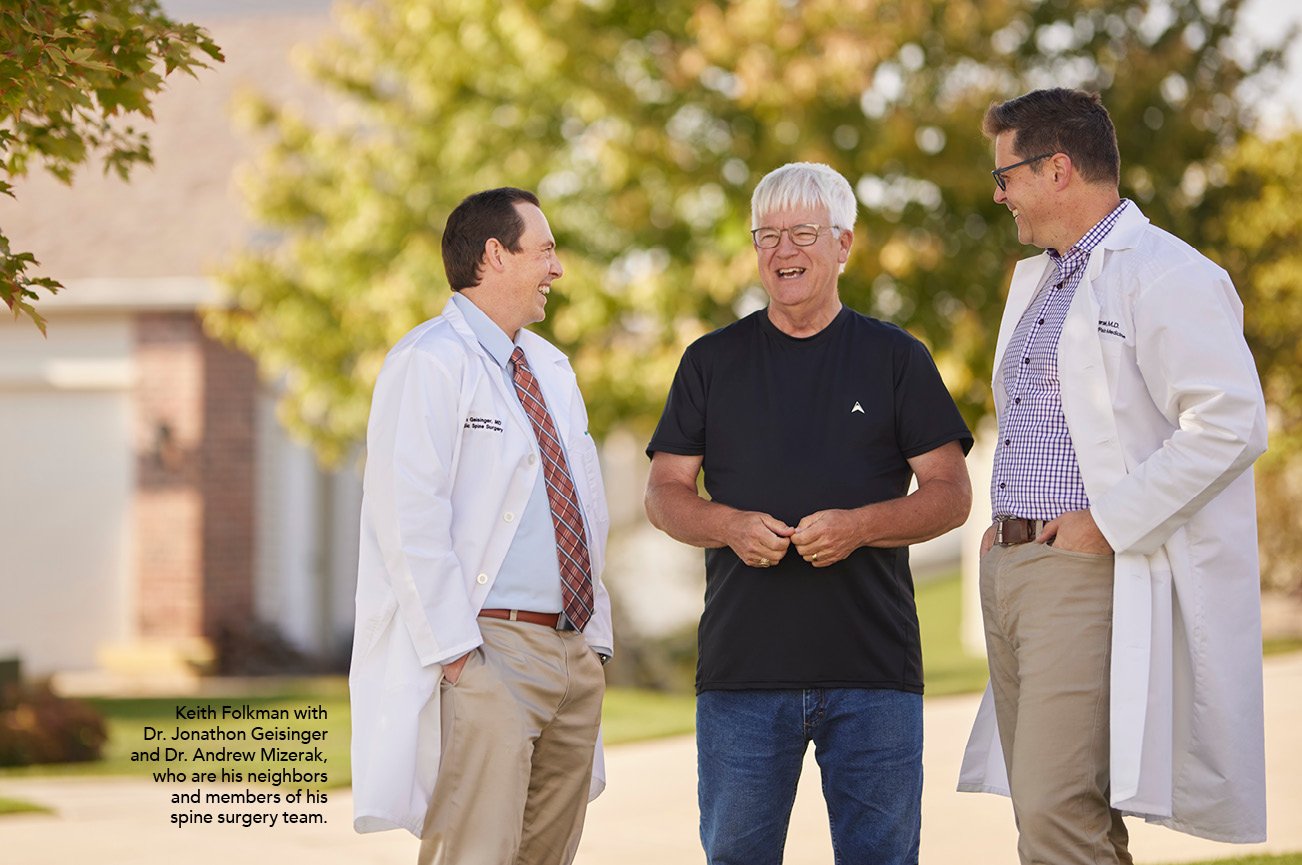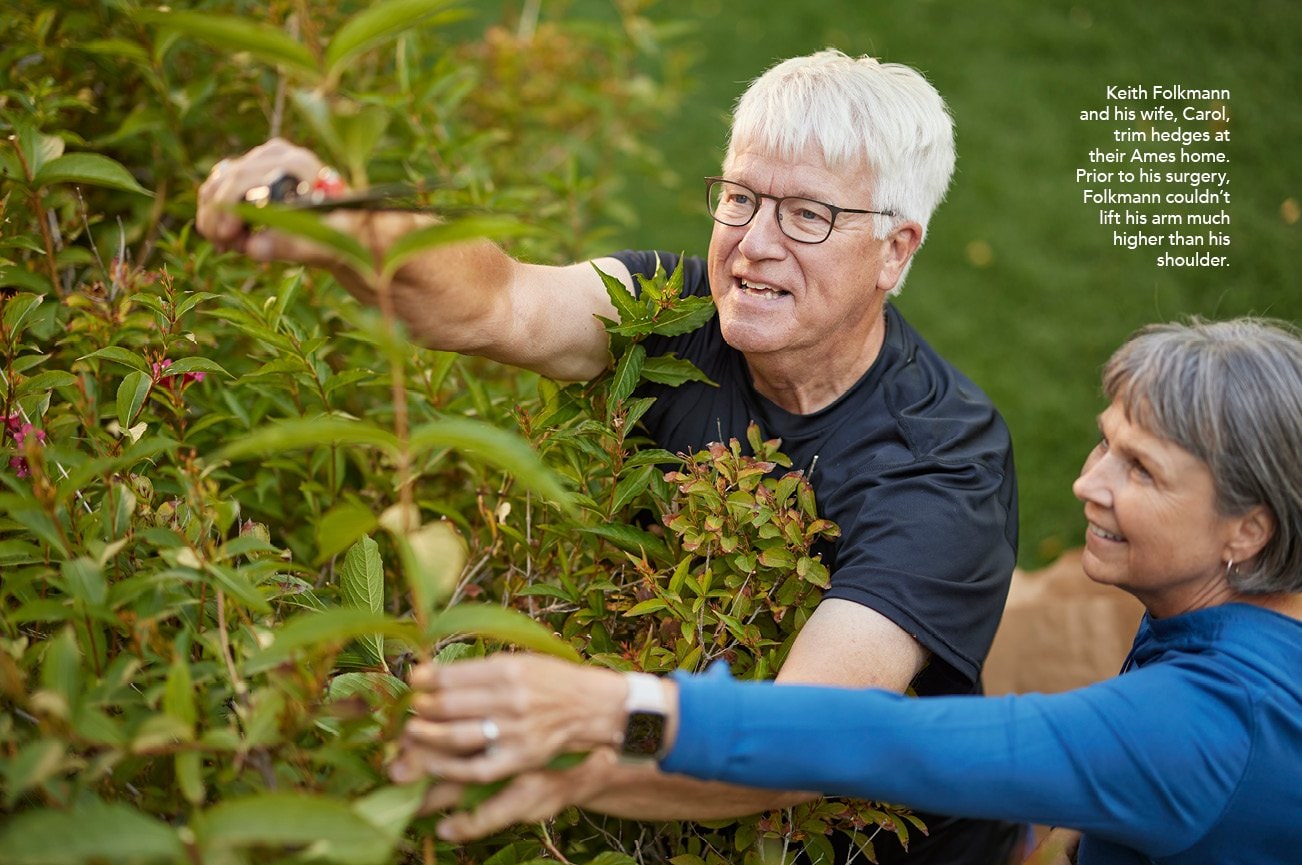
Won't you be my surgeon?
Keith Folkmann found exactly who he needed to help relieve his chronic pain: His neighbors.
By Steve Sullivan
Keith Folkmann’s mom called him her “miracle baby.”
He was a breech birth, and the umbilical cord was wrapped around his throat twice. As if that rough entry into the world wasn’t enough, he also grew up with a chronic muscular-skeletal abnormality that has plagued him all his life. (A doctor once speculated Folkmann may have had an undiagnosed case of polio.)
Despite his health issues, Folkmann has led an active and successful life. When retirement time came around, he had definitely earned it. Severe pain, however, threatened to derail his plans. The miracle baby needed a kind of medical miracle. He found it next door when he met his new neighbor, Dr. Jonathon Geisinger, a McFarland Clinic spine surgeon.
“I knew Dr. Geisinger was the person I needed to be with,” Folkmann said. “He was caring. He took his time and communicated very well, and he wanted to be as thorough as possible.”
Geisinger is honored when friends, family, or colleagues come to him with questions about their spine-related issues.
“It is an even greater honor when they ask me to do their surgery. It is special because these are the people that see me and the results of my work and have taken the next step to entrust me with their own life,” he said. “But as special as that is, when the sterile drapes go up, surgery is the mission and flawless execution is always the goal. I often think about the trust that people put in me as they are going to sleep for surgery, and that trust is never something I take for granted.”
ABNORMALITY
Folkmann has abnormal muscle development around his scapula, or shoulder blade. The muscle system around the scapula is complex, and any abnormality can cause serious, long-term problems. As a kid, Folkmann’s shoulder often sagged, prompting his parents to tell him to sit up straight when he was at the dinner table.
Folkmann’s physical challenges didn’t hold him back. He was an active young man, working on the family farm near Williamsburg and playing sports in high school. A school counselor once arranged a full-tuition scholarship to Iowa State University based on Folkmann’s disabilities. He turned it down, saying, “I’m not disabled, but thank you very much. Give it to someone more disabled than me.”
He attended Iowa State, but juggling work and school was difficult, and he left before finishing his degree. (He eventually earned a business degree in 1991.)
He started working at Sundstrand (now Danfoss, a multinational industrial engineering manufacturer). He began as a night shift parts washer and climbed the ladder, retiring after nearly 44 years as a global vice president. As an executive, he had responsibilities for plants around the world, including Japan, Germany, Slovakia, and China. That meant a lot of travel. When TSA began screening airport passengers, Folkmann was always pulled aside for a pat down because TSA agents never knew what to make of security scanner’s images of the unusual structure of his shoulder. They thought he might be concealing something.
PAIN
Before retirement in 2015, he started to have hand tremors, which several members of his family have also experienced. Dr. Edward Clemmons, a McFarland Clinic neurologist, suggested Folkmann would be a candidate for deep brain stimulation surgery. This involved a small transmitter placed in his chest with probes that went across his collarbone to the back of his neck and then behind his ear and under the scalp to the top of his head. The probes sent signals to his brain whenever he started having a tremor.
In 2019, Folkmann began having back issues. Physical therapy and cortisone shots brought some relief. Eventually he had surgery to relieve pressure on his lower back.
Then, in 2021, he was having excruciating pain from his neck and into his right shoulder and arm. Soon he couldn’t lift his arm much higher than his shoulder. He was referred to Dr. Godfrey Thuku, a McFarland Clinic pain medicine specialist.
“I was wondering what God’s plan for me was as I reached this point in my life. Retirement. Kids grown. Ten grandchildren. This is when there’s a chance to do the things I enjoy – fishing, hunting, working in the yard, traveling. My fear is that this would interrupt or cut that short,” Folkmann said.
Therapy and more injections helped to control the pain, but he continued to lose range of motion and strength. He was then referred to Dr. Geisinger.

Let's Tap Some Spinal Stats
 Mary Greeley's spine surgery program is a busy one.
Mary Greeley's spine surgery program is a busy one.
In the last year, the Mary Greeley spinal surgery team has performed nearly 300 surgeries. Since joining McFarland Clinic in June 2021, Dr. Jonathon Geisinger has performed just over 400 spine surgeries.
The spine program is multi-disciplinary, involving Surgery, Rehab & Wellness, Radiology, Pain Clinic and the Cardiac Cath Lab.
For example, in the last year, more than 540 spinal MRIs have been performed in Radiology. Pain Clinic visits for spine-related issues topped 4,000.
A minimally invasive procedure called percutaneous kyphoplasty, which is performed in the Cath Lab, involves using a balloon to expand collapsed vertebrae so a special cement can be injected. The procedure, which can restore a damaged vertebra’s height and reduce pain, has been performed 20 times in the Cath Lab over the last year.
Mary Greeley’s Rehab & Wellness, meanwhile, helped nearly 460 spine patients with issues related to lower and upper back and neck.
THE A TEAM
“I first met Keith at a neighborhood gathering and have since visited with him a number of times in our neighborhood. But Keith never mentioned his neck issues. So I was surprised one afternoon when I entered the clinic room and found Keith’s friendly smile.” Geisinger said.
Geisinger explained Folkmann’s condition. “Keith has a unique history that presented several complexities, and in order to diagnose and help Keith, I needed the help of other professionals. And in Keith’s story, one of the things I am very proud of is how Mary Greeley and McFarland Clinic came together to showcase the strength and depth of talent we have in our staff. Physicians, nurses, and therapists all working together to help my neighbor.”
“In Keith’s situation, it was difficult to determine with certainty if his pain and weakness was coming from his shoulder or his neck. I ordered an MRI of Keith’s shoulder and asked Dr. David Sneller, a McFarland orthopedic surgeon, to evaluate Keith. It was determined that his shoulder was not likely the source of Keith’s issue. Concurrently, I asked Dr. Semira Ramic, a McFarland Clinic neurologist, to test Folkmann’s nerves. Dr. Ramic’s nerve study found Keith to have a pinched nerve in his neck. With this information I sat down with Keith, and we discussed his neck and developed a plan.”
Geisinger explained to Folkmann that it was instability in his cervical spine and pinching of nerves that was causing his pain and weakness. What he needed was surgery to take pressure off his nerves and stabilize his cervical spine. This surgery would take three hours but could be done minimally invasively. “This is a sophisticated procedure that requires sophisticated techniques, implants, and skilled anesthesia,” Geisinger explained.
Geisinger discussed the procedure. “I performed the surgery through the front of Keith’s neck. Through a one-inch incision, I was able to access all three levels of the spine that needed to be addressed. I removed the disc and bone spurs that were pinching the spinal cord and nerves. I then inserted 3D printed titanium interbody spacers specially designed to grow into the patient’s bone and stabilize the spine.”
Folkmann may have had some luck going into the surgery as each spacer used for his procedure was 7mm tall – triple sevens. He was fortunate to have his other neighbor, Dr. Andrew Mizerak, a McFarland Clinic anesthesiologist, providing the skilled anesthesia needed for these types of high-level spine surgeries. Folkmann loved the idea of having his two neighbors, Geisinger and Mizerak, performing his surgery. “I was relaxed and as confident as I’ve ever been going into a medical situation,” he said. “I had the A team.”
“What I love most about our hospital and clinic is that we are large enough to offer extraordinary services yet small enough to have our health care professionals living together in this community. We care for everyone we see as if they are our neighbor,” added Geisinger.
Folkmann has gone on to have a remarkable outcome. His surgery was flawless and smooth. He stayed in the hospital for one night and went home the next day. Three months following surgery he is now free of pain and able to do all those things he was afraid he’d lost.
“It’s all been successful,” he said. “God brought the right people into my life at the right time.”
